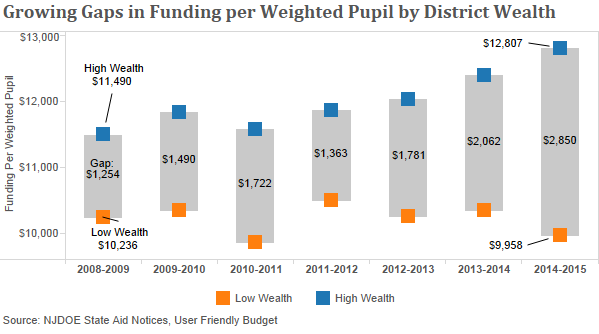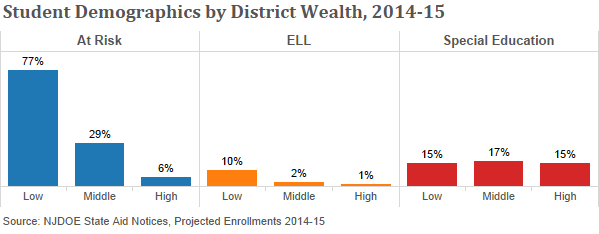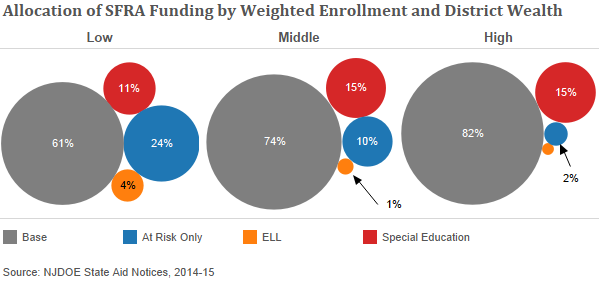FUNDING GAPS WIDEN BETWEEN WEALTHY AND POOR NJ SCHOOL DISTRICTS
February 23, 2015
This school year, New Jersey’s highest wealth school districts had access to $2,850 per pupil more than poor districts, when adjusted for student need. Over the six school years from 2008-09 to 2004-15, need adjusted funding increased in the Garden State’s high wealth districts by 11%, while funding in low wealth districts declined by 3%.
Each year, Education Law Center analyzes district funding under New Jersey’s School Funding Reform Act (SFRA), the state’s weighted student formula enacted in 2008, and approved by the NJ Supreme Court in 2009. ELC’s analysis shows that the funding gaps between low and high wealth districts have nearly doubled since 2009-10, as a result of Governor Chris Christie’s refusal to provide the aid increases required by the formula.
As the following graph shows, funding in high wealth districts grew from $11,490 per pupil in 2008-09 to $12,807 per pupil in 2014-15. In sharp contrast, funding in low wealth districts dropped from $10,236 per pupil in 2008-09 to $9,958 per pupil this school year.

By design, the SFRA formula provides a base level of funding for all students, with additional funding for at-risk (low-income) students, English language learners (ELL), and students with disabilities. An accurate analysis of funding among districts must acknowledge that additional resources are needed to give at-risk, ELL and special education students the opportunity to achieve New Jersey’s core curriculum standards, which now incorporate the Common Core standards in language arts and mathematics.
Under the SFRA, funding is determined by assigning a system of “weights” that represent the additional costs required to augment the base cost allocated for a student with no additional needs. In 2014-15, the base cost is $11,195 per pupil. At-risk students in high poverty districts are funded at 57% above the base cost, or an additional $6,381 per pupil. The funding weights for at-risk students vary according to the district’s overall level of poverty, ranging from 46% to 57%. ELL students are funded at 50% above the base cost, and students who are both at-risk and ELL are funded at the at-risk level plus 12.5% to address the overlap in resources for students who are both at-risk and learning English.
The stark differences in New Jersey’s student populations by district wealth are presented below. In low wealth districts, 77% of students are at-risk, compared to only 6% in high wealth districts. Ten percent of students in low wealth districts are learning English compared to only 1% in wealthy districts. There are only slight differences in special education classification.

The graph below, based on the SFRA’s weighted student funding, shows that in low wealth districts about 61% of total state and local funding is allocated based on the regular educational needs of all students, 24% is for programs and services for at-risk students, and 4% for ELL students (both at-risk and not). In comparison, 82% of funding for high wealth districts is allocated for general educational purposes, only 2% for programs and services for at-risk students, and 1% for ELLs. Taking these funding comparisons into consideration, this analysis shows that high wealth districts have substantially more funding for the general education program than low wealth districts, and the funding gap is growing.

“It is clear that successive years of flat state aid, limited local taxing ability, and a growing at-risk population is taking its toll on students in our poorest districts,” said Danielle Farrie, ELC Research Director. “These districts have to do more with less, while meeting new mandates such as the Common Core standards and assessments. In contrast, wealthy districts have been raising more in local property tax revenue to boost overall funding.” [Click here for a more detailed analysis and individual district data.]
“This data shows that the Governor and Legislature are simply failing to provide our students with the funds needed for success in school,” said David Sciarra, ELC Executive Director. “The SFRA was carefully designed to provide the essential resources all students need to achieve New Jersey’s academic standards, including the Common Core. It’s time to get serious about delivering on that promise.”
Related Stories:
